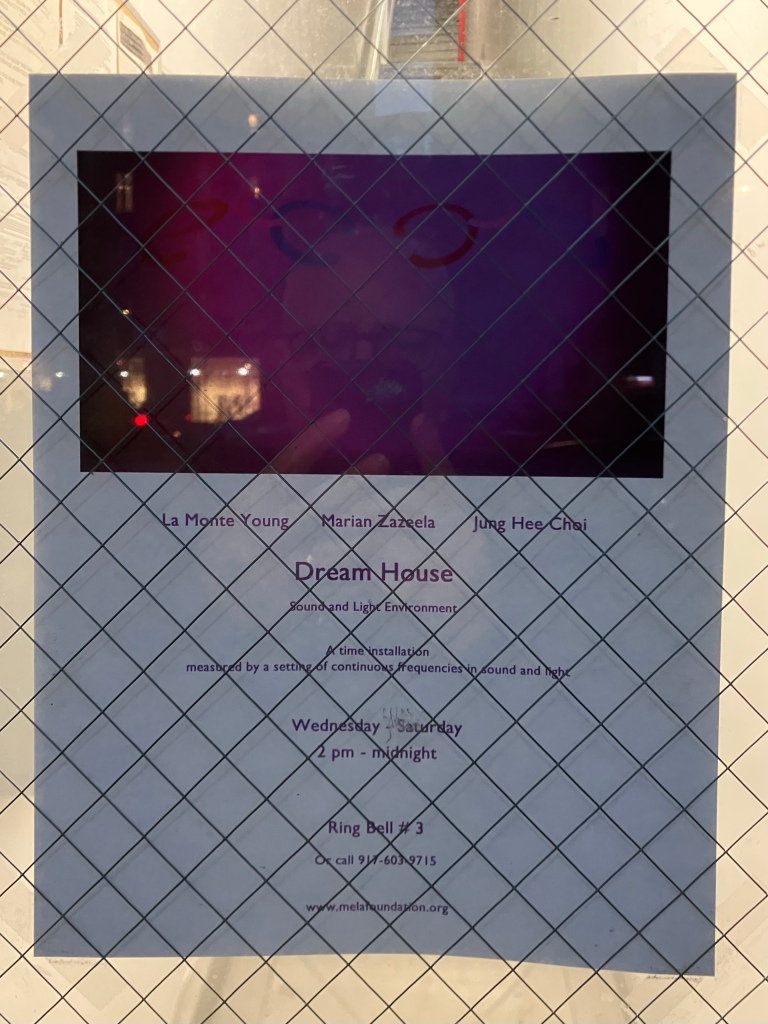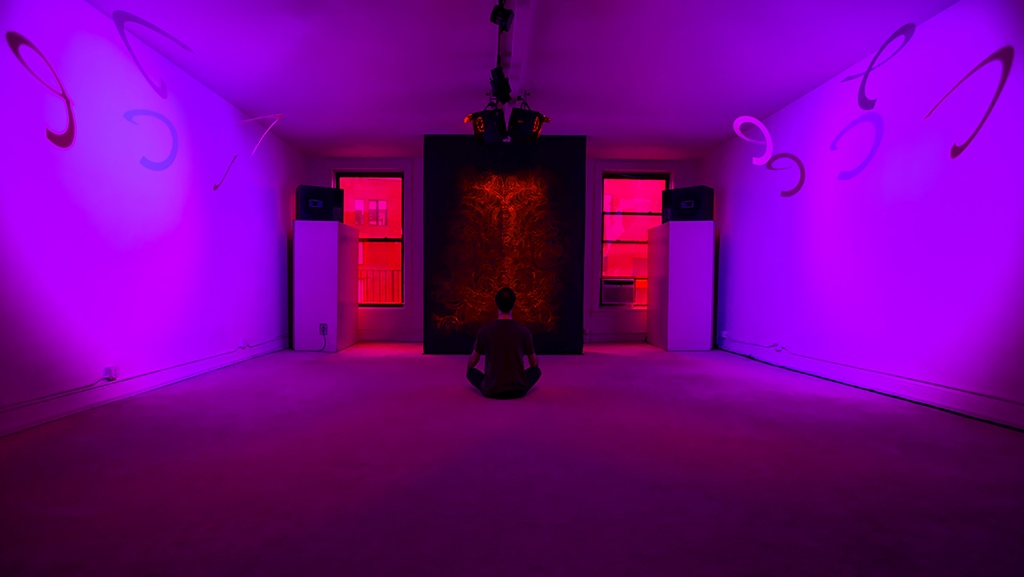You arrive at a nondescript doorway on Church St, near the triangular intersection with 6th Avenue.

Behind a glass pane lined with black diagonal veins is tacked a piece of paper advertising Dream House. A scrappy note taped next to a buzzer on the left of the door gives you instructions to press button 3 for access, and advises that you might have to wait. It also expressly asks you not to press button 2 as it is a private residence. That private residence belongs to La Monte Young and Marian Zazeela, who have lived here since 1963, and who installed Dream House, in the third floor loft above their apartment, following its installation in other locations since it was first developed in 1969.
You ring the buzzer and wait. Nothing happens. You ring again. Still nothing happens. You phone a number on the poster and a laconic female voice eventually answers in a quiet, measured tone, there’s an abrupt mechanical buzz accompanied by a click and the door is unlocked.
As you enter the narrow stairwell, you become aware of an intense, oppressive, tantalising, seductive bass-heavy sound. It feels like you’ve entered a nightclub. There is a feeling of energy. Of promise. Of excitement. Of things about to happen. The sound seems to draw you in. You can’t make out the details fully, almost as if the sounds have been intentionally shrouded or obfuscated.
You ascend the stairs to floor 3 and make small talk with the monitor whose gently musical voice was your key to being permitted entry. She notices your English accent and informs you that there’s a version of Dream House in Germany. You take off your shoes, put $10 in a receptacle that the monitor points at wordlessly, and enter a white-painted door near the top of the stairs.
As you open the door, you first notice the intensity of the volume. It is so immediately overpowering that your body feels both repelled and attracted by its force. As the door closes softly behind you, you feel completely enveloped. You turn left, toward a square room at the end of the passageway. A multicoloured neon sign on the ceiling bears the words ‘Dream House’. This is Zazeela’s Dream House Variation I light sculpture.
A fellow guest, seated on a cushion in the main gallery, turns her head as you approach, even though your shoeless movements are barely detectable. You softly pad along the carpeted corridor to the square room and seat yourself against the wall immediately to the left of the entry way.

Photo: Jung Hee Choi. Copyright © La Monte Young, Marian Zazeela, Jung Hee Choi 2023.
The whole room is bathed in a pink light and infused with the smell of incense. Spiralling crescent shapes are suspended from the ceiling, swaying gently and imperceptibly and bathed in lights from a series of spotlights. Together, the mobiles and lights form Zazeela’s Imagic Light, while the atmospheric pink lighting is itself another Zazeela artwork, Magenta Day / Magenta Night.
Between the two covered windows is a freestanding rectangular object containing a pattern that seems to move elusively as you try to decode it, comprising tiny details picked out with either LEDs or which reflect the coloured lights on the ceiling. Sometimes the pattern looks like a bear. Other times it is formless, spiralling, elusive shapes that writhe and twist like the crescent mobiles above. This is Jung Hee Choi’s Light Point Drawings Nos. 27, 28, 29 and 30 with still lights. A framed photograph of Pandit Pran Nath, Young’s and Zazeela’s guru, hangs on the opposite side of the room, next to the entrance. A bowl beneath it on a table may or may not contain the incense you can smell. Elsewhere, there is a photograph of Ustad Abdul Wahid Khan, a singer and teacher, whose students included Nath.
There are four tall white rectangular columns, each one occupying a corner of the room, with a large speaker placed on its top. The speakers are trained diagonally toward the centre of the carpet. It is from these that the intense sound is projected. The sound piece is Young’s The Base 9:7:4 Symmetry In Prime Time. Or, to give it it’s full title, The Base 9:7:4 Symmetry in Prime Time When Centered above and below The Lowest Term Primes in The Range 288 to 224 with The Addition of 279 and 261 in Which The Half of The Symmetric Division Mapped above and Including 288 Consists of The Powers of 2 Multiplied by The Primes within The Ranges of 144 to 128, 72 to 64 and 36 to 32 Which Are Symmetrical to Those Primes in Lowest Terms in The Half of The Symmetric Division Mapped below and Including 224 within The Ranges 126 to 112, 63 to 56 and 31.5 to 28 with The Addition of 119.
It is many things all at once. There is an obvious droning quality to the sound, but it is impossible to detect any distinct, discrete layers. You try to hear the intersections and anticipate the microtonal collisions, but it is impossible. You settle into the sound. You breathe deeply and listen both intently but also lightly.
After a while, it seems that distinct motifs appear within the sound. A sort of metallic, industrial ringing emerges out of the otherwise impenetrable bass envelopes, which you begin to recognise as a rapidly oscillating pulse rather than a block of held tones. You move your head slightly and the whole sonic image shifts and changes. Now a repeated, drum-like rhythm reveals itself. You move your head again, shift your position against the wall and it vanishes, leading you to conclude it possibly wasn’t ever there. You turn your head again and a new rhythmic device seems to appear. New frequencies which you’re sure weren’t there before seem to scream loudly.
Outwardly, nothing about this is serene. The sound rings uncomfortably in your ears. The relentless bass sits on your chest like a heavy weight. As I lean against the wall I can feel the vibrations in my spine. One of the other temporary residents of Dream House stands up, gathers her belongings and walks past you toward either the door or the smaller room at the other end of the corridor, which contains another light installation, Color (CNN/Twitch): live realization v.2, and a sound piece, The Tone-field: perceptible arithmetical relations in a cycle of eight Indian raga scale permutations, 23 IX 23 – 24 VI 20, New York, both by Choi.

Photo: Jung Hee Choi. Copyright © Jung Hee Choi 2023.
As she moves past you, the departing temporary resident seems to abruptly cause the sound to change, as if she has disrupted the entire balance of the air hosting the sound waves as they cluster tightly in the centre of the room. Someone else decides to leave. The same thing happens again. You now know why your arrival prompted someone to turn their head: you have unintentionally created an interruption and, whether illusory or not, the sound seems to have adjusted itself to another surface to be both absorbed and deflected by.
And yet, while its intensity might be, at all times, cloying and extreme, you find yourself strangely comforted by it. I stayed there for around an hour. I was becalmed and also changed, in ways that I have only ever felt through meditation, experiencing a particularly visceral piece of art, or when I’ve performed John Cage’s 4’33”. My senses seemed suddenly sharper. Details that I hadn’t noticed before became more pronounced. Everything seemed at once more vivid, more colourful, more real. In short, I felt completely and utterly alive.
You leave the loft, pausing in at Choi’s works in the smaller East Gallery. The discordant collision – or maybe symbiosis – between Choi’s The Tone-field and Young’s The Base 9:7:4 Symmetry In Prime Time is discomfiting and unsettling, but also energising.
You descend the narrow stairs with the post-nightclub throb ebbing away behind you, and push the door open onto Church Street. You half expect to be suddenly drowned out by the harsh sonic savagery of Downtown Manhattan as Friday evening gets underway. You are reminded of a quote about New York from Giovanni’s Dream by James Baldwin: “There’s such power there – everything is in such movement.”
Except that it wasn’t like that at all. New York seemed strangely muted, its volume dulled, its lurid lightshow dimmed manifestly. It was as if Dream House had out-intensified New York’s intensity, either through force, volume, or more than likely just the way it had given you an enlarged and heightened sense of perspective.
As you walk down Church toward Canal, you stop, turn and glance back at the nondescript doorway and the building that it sits within. There is nothing remarkable there. It is an elegant loft building among many elegant loft buildings, barely distinguishable and possibly illusory. You look for the covered windows on the third floor but can’t make out anything obvious at all. The hum of traffic, sirens and conversations hide any trace of the sound uncoiling ceaselessly and so intensely behind that doorway. People walk past, fully oblivious, unaware, unbothered.
As you head back uptown, dealing with the serial interruptions of mistimed traffic intersections and Baldwin’s depiction of power and movement, you start to doubt that you were ever actually there. But then you notice echoes of Dream House sounds everywhere, wherever you turn, as if it was simply an amplified version of everything you experience every day in New York.
You smile, breathe, and walk on.
With thanks to Jung Hee Choi. This visit to Dream House took place on 9 February 2024.
For more information and to visit Dream House go to www.melafoundation.org
Words: Mat Smith
(c) 2024 Further.












You must be logged in to post a comment.